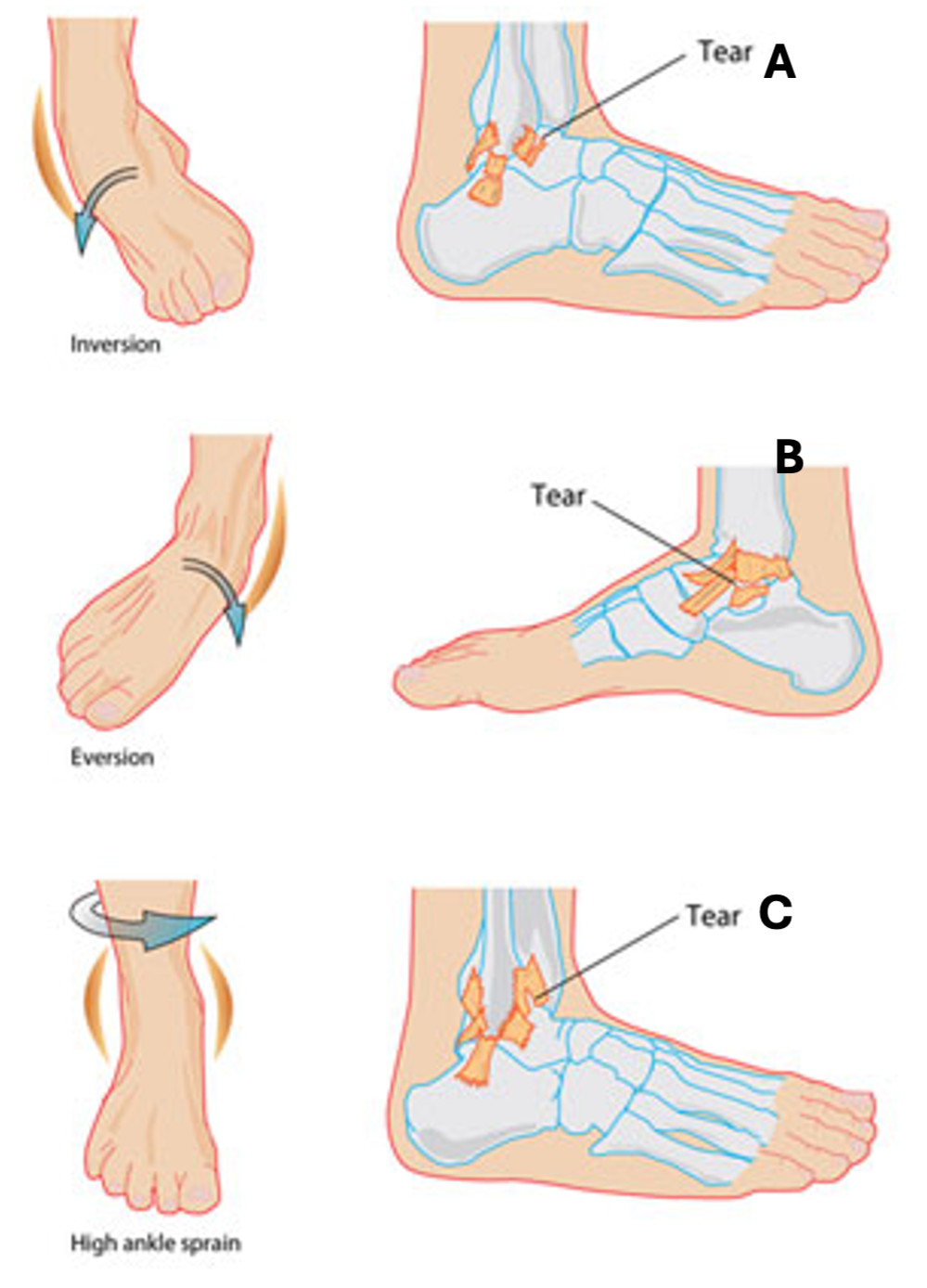What are ankle sprains and what do I do about them?
An ankle sprain is damage to the ligaments (tissue that connects bones together) when they are stretched beyond their normal range of motion and can vary in severity.
There are different types of ankle sprains depending on how the ankle is injured. See Image 1, where:
A) Lateral (outside) ankle sprain
B) Medial (inside) ankle sprain
C) High ankle sprain (syndesmotic injury), which also involve ligaments of the lower leg
These are graded as either grade 1(stretched ligaments), 2 (partial tear), or 3 (full tear). Typically high grade and (C) ankle sprains may involve fractures of bones.
Image 1 - Mechanisms of ankle sprain injuries
Potential Causes
Excessive rolling out (inversion) – injury to the outside of your ankle (lateral ankle sprain). The anterior talofibular ligament is the most commonly injured, however, you may also injure the calcaneofibular and posterior talofibular ligament (Image 2).
Excessive rolling in (eversion) – injury to the inside of your ankle (medial ankle sprain). The ligaments on the inside of the ankle are collectively known as the deltoid ligament.
Excessive outwards twisting or bending of foot upwards (dorsiflexion) – high ankle sprains involve the ligaments that attach the tibia to fibula.
Image 2 - Ligaments on the outside and front of the ankle
As lateral ankle sprains are the most common, the following information relates to this type of injury.
Risk Factors
Lateral ankle injuries are common amongst the general population and those who participate in sports. Risk factors for lateral ankle sprains include:
A decrease in your body's awareness of its position and movement in space (proprioception).
Certain sports including basketball, netball, field sports, indoor volleyball and, of course, ballet.
Any preseason deficiencies in balance and control.
Being female – tendency of greater flexibility.
Abnormalities in ankle, knee and foot alignment.
Reduced ankle dorsiflexion.
Hypermobility.
Ankle Sprains Grading
Grade 1 (mild)
Ligament fibres are slightly stretched or have a very small tear.
Symptoms include mild pain, swelling, and tenderness.
You can usually still bear weight and walk without significant difficulty.
Recovery typically takes a few days to a couple of weeks.
Grade 2 (moderate)
·Ligament is partially torn.
Symptoms include moderate pain, swelling, tenderness, and difficulty bearing weight.
The ankle may feel unstable.
Recovery can take several weeks to a few months.
grade 3 (severe)
Ligament is completely torn or ruptured.
Symptoms include severe pain, significant swelling, and inability to bear weight.
The ankle may be unstable and require immobilisation.
Recovery can take several months.
It is important to seek medical attention to ensure that a fracture isn’t missed and to minimise the risk of ongoing instability (chronic ankle instability). Chronic ankle instability may result in long-term absence from work and sports.
The Perth Podiatrists can assist you by:
Providing you with an accurate assessment.
Providing you with referrals for imaging when required (more about imaging here).
Creating a timeline for your recovery and developing an individualised rehabilitation program involving functional support and exercise therapy.
Providing immobilisation if you are in significant pain, have a high ankle sprain, or a fracture.
Addressing any muscular or balance deficiencies.
Assessing for any foot alignment issues, such as flat feet or high arches (more about gait analysis here).
Reviewing and providing footwear recommendations.
Providing Orthotic therapy (more about custom orthoses here).
Offering or recommending appropriate braces for recurrent injuries.
What to do if you believe you have sprained your ankle:
Follow the RICE protocol, as follows:
Rest: Avoid activities that cause pain and minimise walking, using crutches if needed.
Ice – Apply ice packs (wrapped in a damp towel) to the injured area for 15-20 minutes every 1-2 hours while awake.
Compression – Use a firm bandage from the toes to above the ankle, ensuring it doesn't restrict blood flow.
Elevation – Raise the ankle above heart level to reduce swelling, especially at night.
If you have extensive ecchymosis (bruising), pain, and swelling, it is recommended you seek professional attention.
14 April 2025
Kaitlyn Buffon, Doctor of Podiatric Medicine (DPM) – Perth Podiatrist
Book a consult
Don't let foot or ankle pain hinder your mobility and affect your overall wellbeing. The Perth Podiatrists are here to help! Our team of highly qualified podiatrists specialise in diagnosing and treating foot and ankle conditions, from common ailments to complex issues.
Don't hesitate to book an appointment with The Perth Podiatrists and let us help you regain your confidence in your ankle and get you back to doing what you love!



